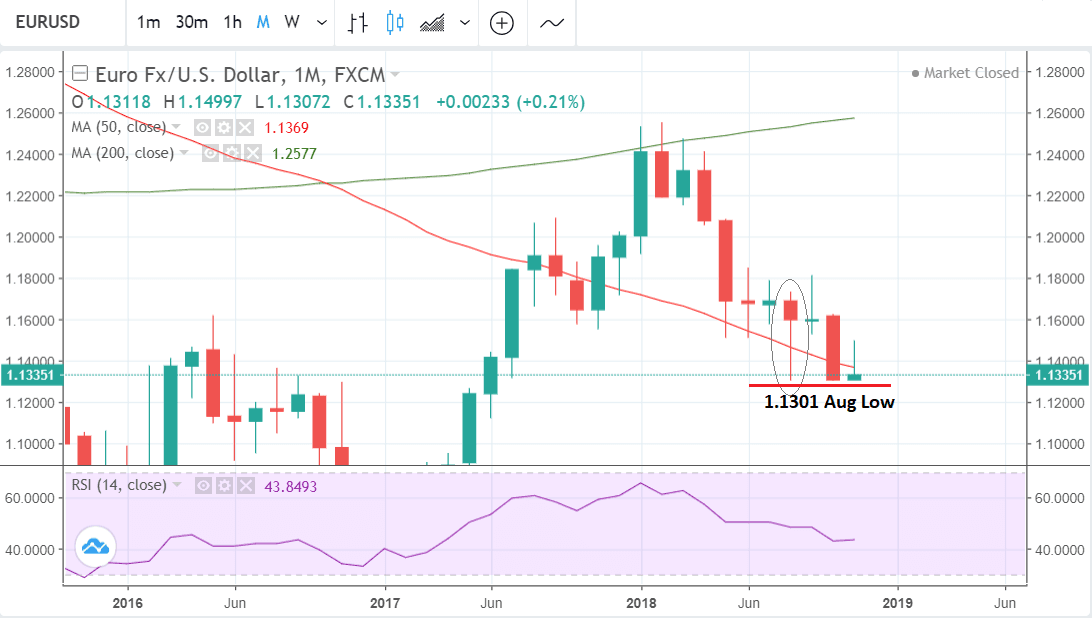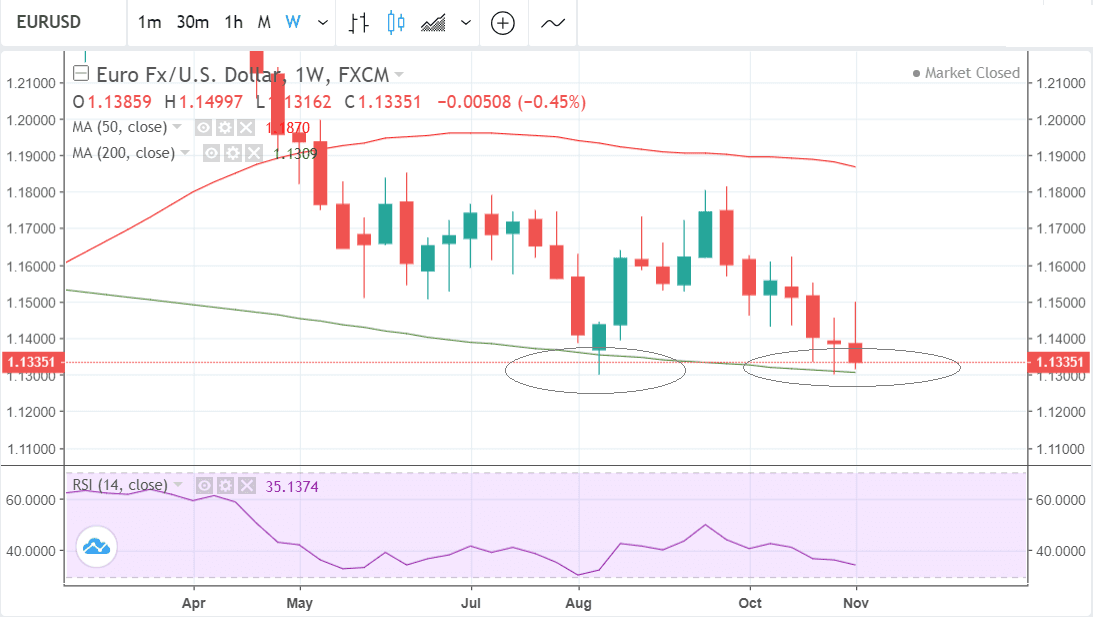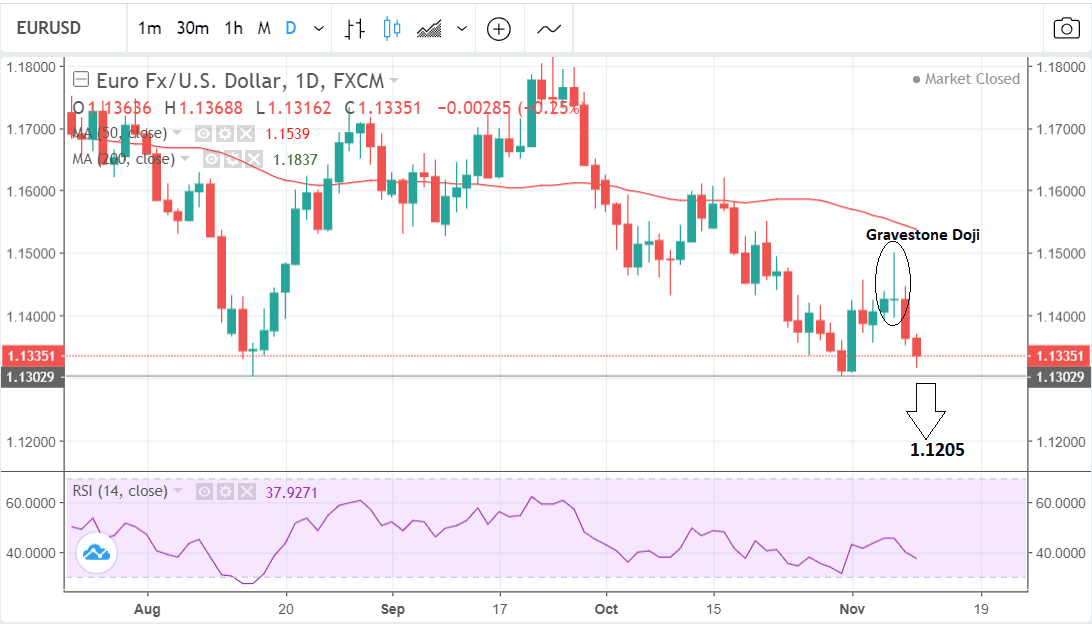Euro-to-Dollar Rate in the Week Ahead: Will the 1.13 Floor Continue to Hold?

Image © European Central Bank.
- EUR/USD increasingly seen threatening 1.13
- Floor could give way to next target at 1.1205
- Key release for the Euro is CPI; for Dollar 'Thanksgiving day effect'
The EUR/USD pair keeps knocking at the door of the circa 1.1300 hard floor, and the risks are building that it could finally break below it in the week ahead.
The pair touched and bounced off the floor in October and after recovering to its November 7 highs, which were a hair's breadth short of 1.1500 it relapsed and has since fallen back down to trade in the 1.13s again, within close proximity of the long-term floor.
It is not surprising 1.1300 has held so robustly when you take a look at the longer-term charts - substantial support underpins the level.
The monthly chart, for example, shows how the 50-month moving average (MA) is providing underpinning support to the exchange rate and that is probably partly why we have seen multiple bounces.
The weekly chart is telling a similar story with the 200-week MA playing the same role as the 50-month on the longer-term chart. The pair has so far respected the 200-week quite obediently, bouncing off it several times.
There is a theory in technical analysis, however, that in relation to support levels prices sometimes act like stones skimming across a surface of water, which often bounce several times but each time the chances increase that they will sink.
This is also the case the current 1.13 level on EUR/USD, and given overarching political risk in Italy, we see an increasing possibility the pair could break below the 1.1301 August low and 'sink' in its own way.
For confirmation of such a break we would first want to see a breakdown below 1.1280, for the purposes of confirmation, however assuming such that happened, the exchange rate would probably be expected to continue lower to a target at 1.1205 where the S1 monthly pivot is situated and touted to provide resistance, if only temporarily at that level.
The imperfect 'gravestone doji' Japanese candlestick pattern at the November 7 highs is, as the name suggests, a bearish signal often found at market peaks, and this, in particular, lends the chart a bearish tilt.
Advertisement
Bank-beating EUR/USD exchange rates: Get up to 5% more foreign exchange by using a specialist provider to get closer to the real market rate and avoid the gaping spreads charged by your bank when providing currency. Learn more here
The Euro: What to Watch this Week
One strong driver for the Euro in the week ahead is likely to be Italian politics as the government reaches the deadline for presenting its revised budget to the European Commission on Tuesday, November 13.
Reports in Italian newspapers, however, suggest the government has only made minor tweaks to the budget and left the 2.4% deficit in place. This is likely to lead to a further stand-off between Rome and Brussels and potentially more volatility for the Euro.
The European Commision is considering imposing sanctions on Italy if it does not play ball including a fine equivalent to 0.2% of economic output, or the withholding of EU funds earmarked for programmes in the country.
Recent GDP data for the Eurozone in Q3 showed Italy lagging other core members with zero growth in the third quarter. Rather than encourage prudence, however, it has had the opposite effect with members of the Italian government now more keen to increase spending in order to inject some fiscal stimulus into the flatlining economy.
“We’re seeing the economy slowing, so all the more reason (for an expansive budget)," said League deputy Massimo Garavaglia.
On the hard data front, the Euro could also be moved by some fairly significant data releases.
Although only revisions of flash estimates - Q3 GDP out on Wednesday at 10.00 GMT and CPI for October out on Thursday (also at 10.00) could still impact on the Euro if they are revised up or down.
The low flash estimate of GDP has led to fears the ECB may not continue with its plans to reduce monetary stimulus. This has weighed on the Euro, however, if there is an upward revision to GDP it could support the Euro.
A major part of the reason for the slowdown was probably due to the rise in the cost of imported fossil fuels from Russia. However, since peaking in June and September the price of oil has fallen and this might lead to an upwards revision.
The trade balance for September is out at 10 on Thursday and is likely to show the surplus shrinking further. This is due to the price of oil which peaked in September and therefore probably eroded the surplus in that month.
The ZEW economic sentiment survey, which is an important leading economic indicator for growth, is out on Monday at 10.00.
The ZEW is compiled using responses from 350 German finance professionals.
A positive result shows the balance of answers were optimistic and vice-versa for a negative result. In October the ZEW was -19.4 as investors expressed concerns about international trade relations.
Finally, Eurozone industrial production figures for September are due to be released at 10.00 on Wednesday and forecast to show a slowdown of -0.3 after a 1.0% rise in August.
The Dollar: What to Watch this Week
The most important event in the week ahead for the Dollar is probably actually the US national holiday, Thanksgiving day.
There is a 'Thanksgiving Day effect' in FX markets in which US Dollar pairs tend to narrow their range on Thanksgiving day and then breakout on the Friday after.
The effect is put down to a lack of liquidity due to US traders taking the day off.
The 'Thanksgiving effect' was discovered by Kathy Lien, the managing director of BK Asset Management. The chart below shows how ranges contract in key dollar pairs on Thanksgiving Day and then expand on the Friday after.
Another major release for the U.S. Dollar is CPI data which is forecast to increase by 0.3% on a month-on-month (mom) basis in October from 0.2% in September, when it is released on Wednesday at 13.30 GMT. A beat of expectations could well fuel the ongoing rally in the Dollar.
PPI inflation numbers out on Friday came in well ahead of expectation, suggesting that price pressures in the economy are building.
Core CPI is probably more indicative of domestic price pressures, more relevant to monetary policy and therefore more impactful on the Dollar - it is expected to rise by 0.2% on a monthly basis and keep its year-on-year growth at 2.2%. If so the Dollar will probably remain well-supported as this suggested the Fed continuing with the current policy trajectory.
Analysts at Wells Fargo see a probable 'tariff effect' pushing up prices and lending a positive bias to October's CPI data.
"Looking ahead, we expect price pressures to steadily build, as more businesses feel pressure from tariffs. Tariff effects may be drawn out, since businesses may have some ability to absorb increased costs, but with capacity tight, they may find it easier to pass on higher input costs to consumers. We expect the CPI to climb to 0.3% in October," say Wells Fargo in a foreign exchange briefing to clients.
Another important event for the Dollar is a speech by Chairman of the Fed Jerome Powell on Wednesday at 23.00, and his speech on Thursday at 16.30. Powell will probably simply reiterated the relatively hawkish guidance provided at last week's FOMC given the short duration since the meeting, but if he changes stance or ups his rhetoric, it could impact on the Dollar.
The general consensus appears to be tilted towards expecting more hawkish commentary rather than dovish, which would strengthen the Dollar.
Retail Sales is expected to show a 0.6% rise in October compared to the previous month when it only rose by 0.1%. if this acceleration in buying materialises it may provide an updraught for the Dollar, although given the releases on Thanksgiving Day when USD pairs usually remain with tight ranges any reaction to data could be delayed until Friday when USD is prone to volatility. Since most economic growth in the US is driven by the consumer a rise in retail sales is usually a sign of strong growth and therefore supportive of the currency.
Other key data out on Thursday includes the NY Empire State as well as the Philadelphia Fed Manufacturing Indices in November. Both are expected to show marginal declines.
Industrial production is scheduled for release on Friday at 14.15 when it is expected to show a slightly slower 0.2% rise in October over the 0.3% increase noted in September.
Advertisement
Bank-beating EUR/USD exchange rates: Get up to 5% more foreign exchange by using a specialist provider to get closer to the real market rate and avoid the gaping spreads charged by your bank when providing currency. Learn more here













